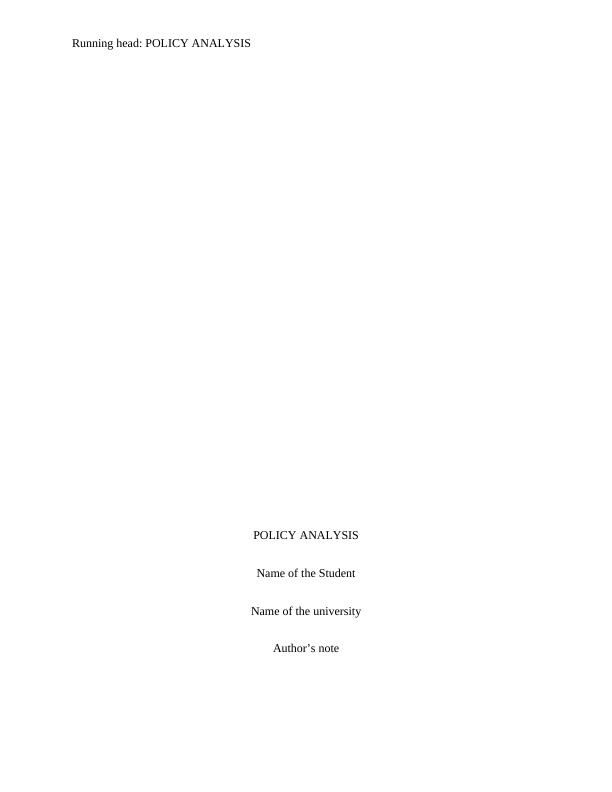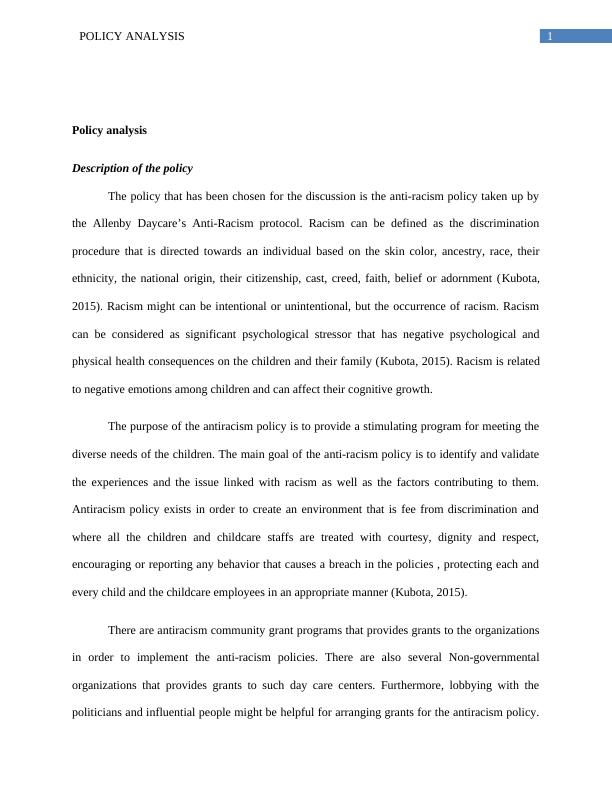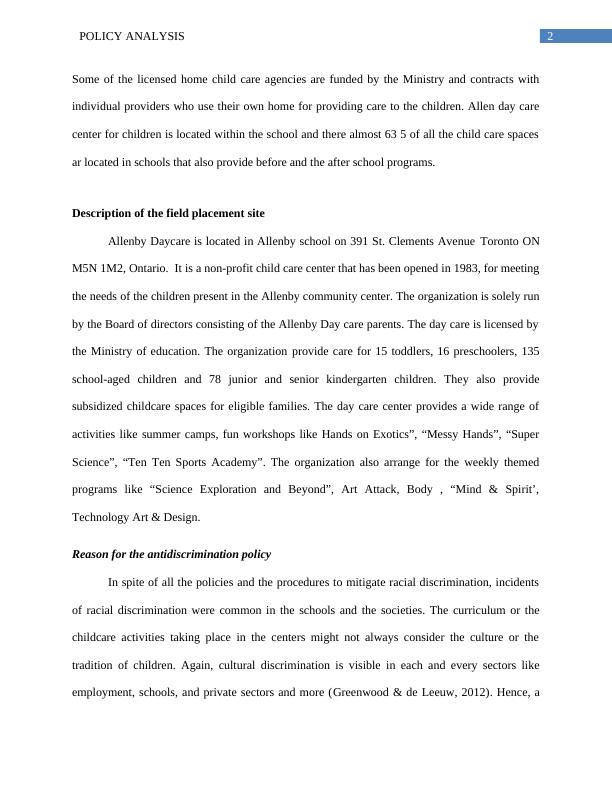Policy Analysis
Added on 2023-04-19
12 Pages3170 Words243 Views
Running head: POLICY ANALYSIS
POLICY ANALYSIS
Name of the Student
Name of the university
Author’s note
POLICY ANALYSIS
Name of the Student
Name of the university
Author’s note

1POLICY ANALYSIS
Policy analysis
Description of the policy
The policy that has been chosen for the discussion is the anti-racism policy taken up by
the Allenby Daycare’s Anti-Racism protocol. Racism can be defined as the discrimination
procedure that is directed towards an individual based on the skin color, ancestry, race, their
ethnicity, the national origin, their citizenship, cast, creed, faith, belief or adornment (Kubota,
2015). Racism might can be intentional or unintentional, but the occurrence of racism. Racism
can be considered as significant psychological stressor that has negative psychological and
physical health consequences on the children and their family (Kubota, 2015). Racism is related
to negative emotions among children and can affect their cognitive growth.
The purpose of the antiracism policy is to provide a stimulating program for meeting the
diverse needs of the children. The main goal of the anti-racism policy is to identify and validate
the experiences and the issue linked with racism as well as the factors contributing to them.
Antiracism policy exists in order to create an environment that is fee from discrimination and
where all the children and childcare staffs are treated with courtesy, dignity and respect,
encouraging or reporting any behavior that causes a breach in the policies , protecting each and
every child and the childcare employees in an appropriate manner (Kubota, 2015).
There are antiracism community grant programs that provides grants to the organizations
in order to implement the anti-racism policies. There are also several Non-governmental
organizations that provides grants to such day care centers. Furthermore, lobbying with the
politicians and influential people might be helpful for arranging grants for the antiracism policy.
Policy analysis
Description of the policy
The policy that has been chosen for the discussion is the anti-racism policy taken up by
the Allenby Daycare’s Anti-Racism protocol. Racism can be defined as the discrimination
procedure that is directed towards an individual based on the skin color, ancestry, race, their
ethnicity, the national origin, their citizenship, cast, creed, faith, belief or adornment (Kubota,
2015). Racism might can be intentional or unintentional, but the occurrence of racism. Racism
can be considered as significant psychological stressor that has negative psychological and
physical health consequences on the children and their family (Kubota, 2015). Racism is related
to negative emotions among children and can affect their cognitive growth.
The purpose of the antiracism policy is to provide a stimulating program for meeting the
diverse needs of the children. The main goal of the anti-racism policy is to identify and validate
the experiences and the issue linked with racism as well as the factors contributing to them.
Antiracism policy exists in order to create an environment that is fee from discrimination and
where all the children and childcare staffs are treated with courtesy, dignity and respect,
encouraging or reporting any behavior that causes a breach in the policies , protecting each and
every child and the childcare employees in an appropriate manner (Kubota, 2015).
There are antiracism community grant programs that provides grants to the organizations
in order to implement the anti-racism policies. There are also several Non-governmental
organizations that provides grants to such day care centers. Furthermore, lobbying with the
politicians and influential people might be helpful for arranging grants for the antiracism policy.

2POLICY ANALYSIS
Some of the licensed home child care agencies are funded by the Ministry and contracts with
individual providers who use their own home for providing care to the children. Allen day care
center for children is located within the school and there almost 63 5 of all the child care spaces
ar located in schools that also provide before and the after school programs.
Description of the field placement site
Allenby Daycare is located in Allenby school on 391 St. Clements Avenue Toronto ON
M5N 1M2, Ontario. It is a non-profit child care center that has been opened in 1983, for meeting
the needs of the children present in the Allenby community center. The organization is solely run
by the Board of directors consisting of the Allenby Day care parents. The day care is licensed by
the Ministry of education. The organization provide care for 15 toddlers, 16 preschoolers, 135
school-aged children and 78 junior and senior kindergarten children. They also provide
subsidized childcare spaces for eligible families. The day care center provides a wide range of
activities like summer camps, fun workshops like Hands on Exotics”, “Messy Hands”, “Super
Science”, “Ten Ten Sports Academy”. The organization also arrange for the weekly themed
programs like “Science Exploration and Beyond”, Art Attack, Body , “Mind & Spirit’,
Technology Art & Design.
Reason for the antidiscrimination policy
In spite of all the policies and the procedures to mitigate racial discrimination, incidents
of racial discrimination were common in the schools and the societies. The curriculum or the
childcare activities taking place in the centers might not always consider the culture or the
tradition of children. Again, cultural discrimination is visible in each and every sectors like
employment, schools, and private sectors and more (Greenwood & de Leeuw, 2012). Hence, a
Some of the licensed home child care agencies are funded by the Ministry and contracts with
individual providers who use their own home for providing care to the children. Allen day care
center for children is located within the school and there almost 63 5 of all the child care spaces
ar located in schools that also provide before and the after school programs.
Description of the field placement site
Allenby Daycare is located in Allenby school on 391 St. Clements Avenue Toronto ON
M5N 1M2, Ontario. It is a non-profit child care center that has been opened in 1983, for meeting
the needs of the children present in the Allenby community center. The organization is solely run
by the Board of directors consisting of the Allenby Day care parents. The day care is licensed by
the Ministry of education. The organization provide care for 15 toddlers, 16 preschoolers, 135
school-aged children and 78 junior and senior kindergarten children. They also provide
subsidized childcare spaces for eligible families. The day care center provides a wide range of
activities like summer camps, fun workshops like Hands on Exotics”, “Messy Hands”, “Super
Science”, “Ten Ten Sports Academy”. The organization also arrange for the weekly themed
programs like “Science Exploration and Beyond”, Art Attack, Body , “Mind & Spirit’,
Technology Art & Design.
Reason for the antidiscrimination policy
In spite of all the policies and the procedures to mitigate racial discrimination, incidents
of racial discrimination were common in the schools and the societies. The curriculum or the
childcare activities taking place in the centers might not always consider the culture or the
tradition of children. Again, cultural discrimination is visible in each and every sectors like
employment, schools, and private sectors and more (Greenwood & de Leeuw, 2012). Hence, a

3POLICY ANALYSIS
common approach was necessary to understand racism as a combination of power and prejudice.
It require to make the childcare services more equal and accessible for all the sections of the
society (Greenwood & de Leeuw,2012). One of the main problem that has been identified is that
most of the people are unaware of the actual definitions of “racism” and thus also lack the
perception as of how the racial discrimination can be mitigated (Hiranandani, 2012).. It should
be mentioned that the practice of multiculturalism in liberal democracy is jeopardized by the lack
of clarity in the term “racism’ and “anti-racism”. In most of the cases the antiracism policies
simply cannot be acted on in real or the policies that can be intended for a particular group
might be disadvantageous for the other group (Craig et al., 2015) .
The main stakeholders for the policy procedure are- children, the parents, the governing
body of the school, the assistant heads, the staffs, the indigenous educators and the children. This
is because they are the most effected by the racial discrimination and it is also the responsibility
of the assistant head and the governing body of the school to implement the antiracism policy at
the school. While researching on this particular day care center, it has been found that in most of
the cases the care workers are English speaking and there are no Asian or African staffs in the
center (Currie et al., 2012). The children who are receiving care from this organization often
have diverse culture and traditions. In spite of this, most of the actions and practices taking place
in this organization is as per the convenience of the white children. Instances can be found in the
day care centers where Asian or the African children are bullied or are restricted from
participating in games. This kind of exclusion might make children upset and it is essential that
the teachers should have a complete acquaintances about these kind of discriminative behavior
(Craig et al., 2015).
common approach was necessary to understand racism as a combination of power and prejudice.
It require to make the childcare services more equal and accessible for all the sections of the
society (Greenwood & de Leeuw,2012). One of the main problem that has been identified is that
most of the people are unaware of the actual definitions of “racism” and thus also lack the
perception as of how the racial discrimination can be mitigated (Hiranandani, 2012).. It should
be mentioned that the practice of multiculturalism in liberal democracy is jeopardized by the lack
of clarity in the term “racism’ and “anti-racism”. In most of the cases the antiracism policies
simply cannot be acted on in real or the policies that can be intended for a particular group
might be disadvantageous for the other group (Craig et al., 2015) .
The main stakeholders for the policy procedure are- children, the parents, the governing
body of the school, the assistant heads, the staffs, the indigenous educators and the children. This
is because they are the most effected by the racial discrimination and it is also the responsibility
of the assistant head and the governing body of the school to implement the antiracism policy at
the school. While researching on this particular day care center, it has been found that in most of
the cases the care workers are English speaking and there are no Asian or African staffs in the
center (Currie et al., 2012). The children who are receiving care from this organization often
have diverse culture and traditions. In spite of this, most of the actions and practices taking place
in this organization is as per the convenience of the white children. Instances can be found in the
day care centers where Asian or the African children are bullied or are restricted from
participating in games. This kind of exclusion might make children upset and it is essential that
the teachers should have a complete acquaintances about these kind of discriminative behavior
(Craig et al., 2015).

End of preview
Want to access all the pages? Upload your documents or become a member.
Related Documents
Early Childhood Lab School Assignmentlg...
|6
|1600
|516
Group Symposium- Doclg...
|8
|1931
|388
Enrichment Programs in Ontariolg...
|3
|1414
|449